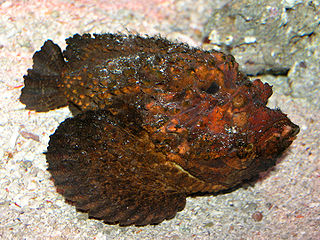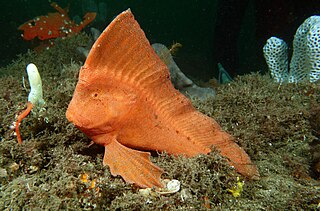
The red velvetfish is a species of marine ray-finned fish, it is the only species in the monotypic genus Gnathanacanthus and monogeneric family Gnathanacanthidae. This species is endemic to the inshore waters of western and southern Australia.

Synanceiinae is a subfamily of venomous ray-finned fishes, waspfishes, which is classified as part of the family Scorpaenidae, the scorpionfishes and their relatives. These fishes are found in the Indo-Pacific oceans. They are primarily marine, though some species are known to live in fresh or brackish waters. The various species of this family are known informally as stonefish, stinger, stingfish and ghouls. Its species are known to have the most potent neurotoxins of all the fish venoms, secreted from glands at the base of their needle-like dorsal fin spines. The vernacular name, stonefish, for some of these fishes derives from their behaviour of camouflaging as rocks. The type species of the family is the estuarine stonefish.

Congiopodidae, commonly known as pigfishes, horsefishes and racehorses, is a family of ray-finned fish classified with in the order Scorpaeniformes. These fishes are native to the Southern Hemisphere.

The Australian prowfishes are a small family, the Pataecidae, of ray-finned fishes classified within the order Scorpaeniformes. Australian prowfishes are distinguished by a long dorsal fin that begins far forward on the head, forming a "prow" shape, and extends all the way to the caudal fin. They lack scales and pelvic fins.

Little velvetfishes or simply velvetfishes are a family, the Aploactinidae, of marine ray-finned fishes classified within the order Scorpaeniformes. They are small fish that have skin with a velvet texture. They live on the sea bottom close to the shore, at depths of up to 100 metres (330 ft). They are found in the Indo-Pacific region.

Apistinae, the wasp scorpionfishes, is a subfamily of venomous, marine ray-finned fishes belonging to the family Scorpaenidae, the scorpionfishes and related species. These fishes are native to the Indian Ocean and the western Pacific Ocean.

Tetraroginae is a subfamily of marine ray-finned fishes, commonly known as waspfishes or sailback scorpionfishes, belonging to the family Scorpaenidae, the scorpionfishes and their relatives. These fishes are native to the Indian Ocean and the West Pacific. As their name suggests, waspfishes are often venomous; having poison glands on their spines. They are bottom-dwelling fish, living at depths to 300 metres (980 ft). These creatures usually live in hiding places on the sea bottom.

Inimicus didactylus, also known as sea goblin, demon stinger or devil stinger, is a Western Pacific member of the Inimicus genus of venomous fishes, closely related to the true stonefishes. It can reach a body length of 25 cm (10 in) and is irregularly surfaced with spines and a knobby appearance. The fish has venomous spines to ward off enemies. The fish are nocturnal, and often dig themselves partially into the sandy seabed during the day. The body is red or sandy yellow and well camouflaged on sandy and coral seabeds.

The wasp-spine velvetfish, also known as the dwarf velvetfish, is a species of marine ray-finned fish, a velvetfish belonging to the family Aploactinidae. It is the only member of the monotypic genus Acanthosphex. This species is found in the Indo-Pacific from India to the Gulf of Thailand.
The visitor, also known as the sandpaper velvetfish,is a species of marine ray-finned fish, a velvetfish belonging to the family Aploactinidae. It is the only member of the monotypic genus Adventor. This species is found the Pacific Ocean waters along the coasts of Papua New Guinea and Australia.
The threefin velvetfish is a species of marine ray-finned fish, a velvetfish belonging to the family Aploactinidae. This species is found the western Pacific Ocean where it has been found on reefs. This species grows to a length of 5 centimetres (2.0 in) TL. This species is the only known member of its genus.

Paraploactis is a genus of marine ray-finned fish, velvetfishes belonging to the family Aploactinidae. The genus is found the Indo-Pacific.
Sthenopus is a monotypic genus of marine ray-finned fish, a velvetfish belonging to the family Aploactinidae. It is found in the western Pacific Ocean where it is known from China and Thailand. The only known member of this genus is Sthenopus mollis.

Easchmeyer nexus is a species of marine ray-finned fish; it is the only species in the monotypic genus Eschmeyer and monogeneric family Eschmeyeridae. This fish is only known from the Pacific Ocean, near Fiji.

Choridactylus is a genus of marine ray-finned fishes, it is one of two genera in the tribe Choridactylini, one of the three tribes which are classified within the subfamily Synanceiinae within the family Scorpaenidae, the scorpionfishes and their relatives. They are commonly known as stingfishes. They are found in the Indo-West Pacific.
Leptosynanceia is a monotypic genus of ray-finned fish belonging to the subfamily Synanceiinae, the stonefishes, which is classified within the family Scorpaenidae, the scorpionfishes and relatives, its only species is Leptosynanceia asteroblepa which is called the mangrove stonefish in Malaysia. This species native to the brackish and fresh waters of Southeast Asia. This species grows to a total length of 23 centimetres (9.1 in). This species is an extremely dangerous fish whose venom can cause a human to die within 1 to 2 hours after contact. The pain caused by the venom is described as "agonizing".

Minous, is a genus of marine ray-finned fishes, it is the only genus in the tribe Minoini, one of the three tribes which are classified within the subfamily Synanceiinae within the family Scorpaenidae, the scorpionfishes and their relatives. They are commonly known as stingfishes. They are found in the Indo-West Pacific.

The blackfin stonefish is a species of venomous ray-finned fish, a stonefish be longing to the subfamily Synanceiinae of the family Scorpaenidae, the scorpionfishes and their relatives. It is the only species in the monotypic genus. It is native to the western Indian Ocean where it occurs in areas with muddy bottoms. This species grows to a total length of 13 centimetres (5.1 in).

The stargazing stonefish is a species of stonefish native to the Indian Ocean and the western Pacific Ocean where it is found on muddy bottoms in estuaries. This venomous species is also a minor component of local commercial fisheries. This species grows to a length of 8 centimetres (3.1 in) SL. This species is the only known member of the genus Trachicephalus.
Liocranium is a small genus of marine ray-finned fishes, waspfishes belonging to the subfamily Tetraroginae, which is classified as part of the family Scorpaenidae, the scorpionfishes and their relatives. The fishes in this genus are found in the eastern Indian Ocean and the western Pacific Ocean.















